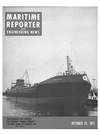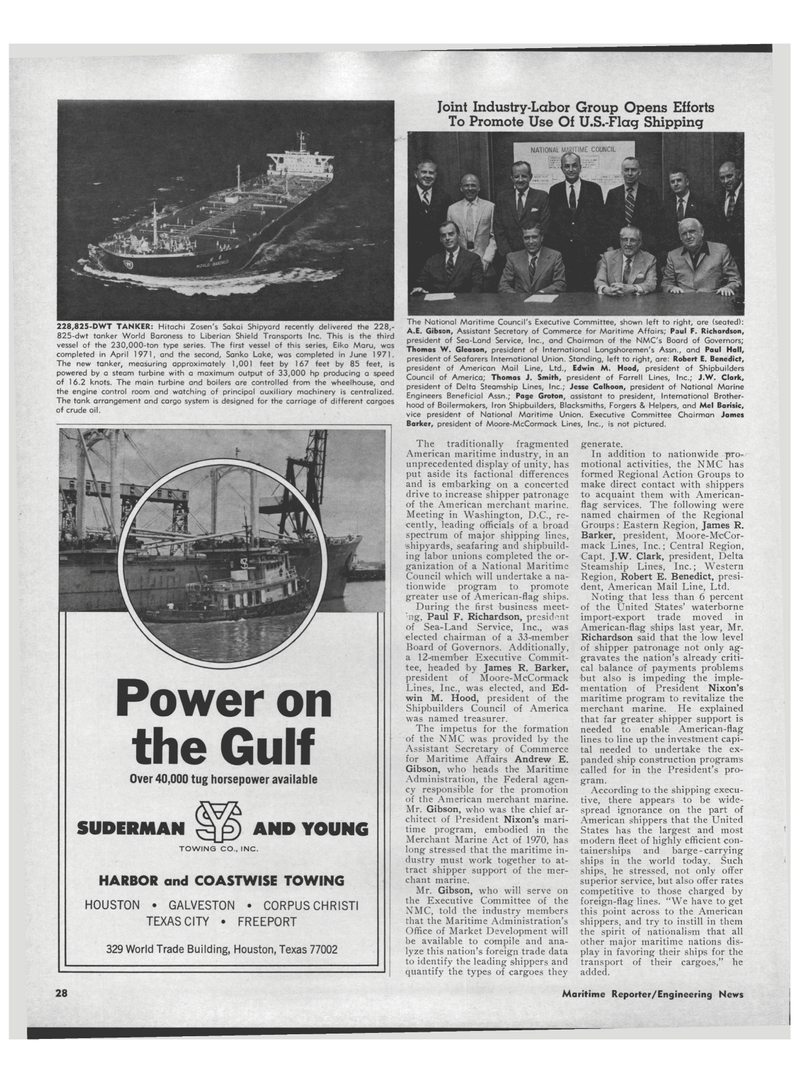
Page 24: of Maritime Reporter Magazine (October 15, 1971)
Read this page in Pdf, Flash or Html5 edition of October 15, 1971 Maritime Reporter Magazine
228,825-DWT TANKER: Hitachi Zosen's Sakai Shipyard recently delivered the 228,- 825-dwt tanker World Baroness to Liberian Shield Transports Inc. This is the third vessel of the 230,000-ton type series. The first vessel of this series, Eiko Maru, was completed in April 1971, and the second, Sanko Lake, was completed in June 1971.
The new tanker, measuring approximately 1,001 feet by 167 feet by 85 feet, is powered by a steam turbine with a maximum output of 33,000 hp producing a speed of 16.2 knots. The main turbine and boilers are controlled from the wheelhouse, and the engine control room and watching of principal auxiliary machinery is centralized.
The tank arrangement and cargo system is designed for the carriage of different cargoes of crude oil.
Joint Industry-Labor Group Opens Efforts
To Promote Use Of U.S.-Flag Shipping
The National Maritime Council's Executive Committee, shown left to right, are (seated):
A.E. Gibson, Assistant Secretary of Commerce for Maritime Affairs; Paul F. Richardson, president of Sea-Land Service, Inc., and Chairman of the NMC's Board of Governors;
Thomas W. Gleason, president of International Longshoremen's Assn., and Paul Hall, president of Seafarers International Union. Standing, left to right, are: Robert E. Benedict, president of American Mail Line, Ltd., Edwin M. Hood, president of Shipbuilders
Council of America; Thomas J. Smith, president of Farrell Lines, Inc.; J.W. Clark, president of Delta Steamship Lines, Inc.; Jesse Calhoon, president of National Marine
Engineers Beneficial Assn.; Page Groton, assistant to president. International Brother- hood of Boilermakers, Iron Shipbuilders, Blacksmiths, Forgers & Helpers, and Mel Barisic, vice president of National Maritime Union. Executive Committee Chairman James
Barker, president of Moore-McCormack Lines, Inc., is not pictured.
The traditionally fragmented
American maritime industry, in an unprecedented display of unity, has put aside its factional differences and is embarking on a concerted drive to increase shipper patronage of the American merchant marine.
Meeting in Washington, D.C., re- cently, leading officials of a broad spectrum of major shipping lines, 'shipyards, seafaring and shipbuild- ing labor unions completed the or- ganization of a National Maritime
Council which will undertake a na- tionwide program to promote greater use of American-flag ships.
During the first business meet- ;ng, Paul F. Richardson, president of Sea-Land Service, Inc., was elected chairman of a 33-member
Board of Governors. Additionally, a 12-mem'ber Executive Commit- tee, headed by James R. Barker, president of Moore-McCormack
Lines, Inc., was elected, and Ed- win M. Hood, president of the
Shipbuilders Council of America was named treasurer.
The impetus for the formation of the NMC was provided by the
Assistant Secretary of Commerce for Maritime Affairs Andrew E.
Gibson, who heads the Maritime
Administration, the Federal agen- cy responsible for the promotion of the American merchant marine.
Mr. Gibson, who was the chief ar- chitect of President Nixon's mari- time program, embodied in the
Merchant Marine Act of 1970, has long stressed that the maritime in- dustry must work together to at- tract shipper support of the mer- chant marine.
Mr. Gibson, who will serve on the Executive Committee of the
NMC, told the industry members that the Maritime Administration's
Office of Market Development will be available to compile and ana- lyze this nation's foreign trade data to identify the leading shippers and quantify the types of cargoes they generate.
In addition to nationwide pro- motional activities, the NMC has formed Regional Action Groups to make direct contact with shippers to acquaint them with American- flag services. The following were named chairmen of the Regional
Groups: Eastern Region, James R.
Barker, president, Moore-McCor- mack Lines, Inc.; Central Region,
Capt. J.W. Clark, president, Delta
Steamship Lines, Inc.; Western
Region, Robert E. Benedict, presi- dent, American Mail Line, Ltd.
Noting that less than 6 percent of the United States' waterborne importjexport trade moved in
American-flag ships last year, Mr.
Richardson said that the low level of shipper patronage not only ag- gravates the nation's already criti- cal balance of payments problems but also is impeding the imple- mentation of President Nixon's maritime program to revitalize the merchant marine. He explained that far greater shipper support is needed to enable American-flag lines to line up the investment capi- tal needed to undertake the ex- panded ship construction program's called for in the President's pro- gram.
According to the shipping execu- tive, there appears to be wide- spread ignorance on the part of
American shippers that the United
States has the largest and most modern fleet of highly efficient con- tainerships and barge - carrying ships in the world today. Such ships, he stressed, not only offer superior service, but also offer rates competitive to those charged by foreign-flag lines. "We have to get this point across to the American shippers, and try to instill in them the spirit of nationalism that all other major maritime nations dis- play in favoring their ships for the transport of their cargoes," he added.
Power on the Gulf
Over 40,000 tug horsepower available
SUDERMAK AND YOUNG
TOWING CO., INC.
HARBOR and COASTWISE TOWING
HOUSTON • GALVESTON • CORPUS CHRISTI
TEXAS CITY • FREEPORT 329 World Trade Building, Houston, Texas 77002 28 Maritime Reporter/Engineering News

 23
23

 25
25
